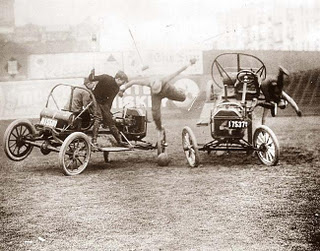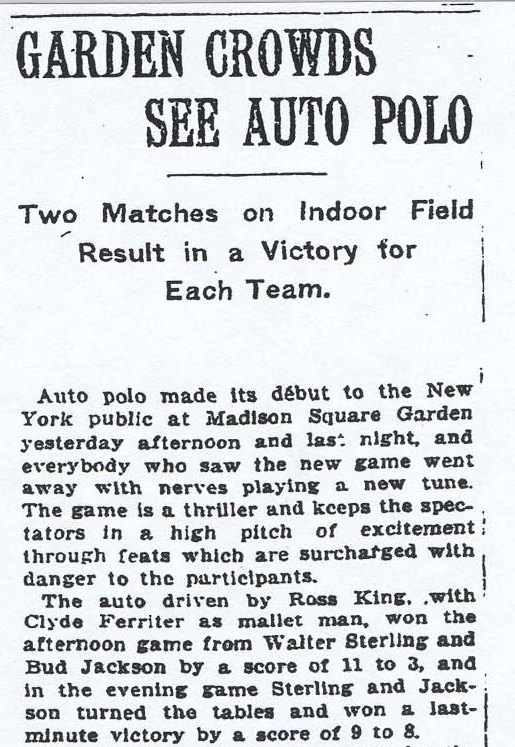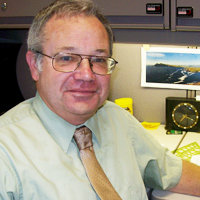< Blog Home Page
Extreme Ferriters
My plan at the beginning of the year was to post something based upon my personal experiences. Meanwhile, my ongoing efforts to identify the locations of family members and to contact them in advance of the All Ferriter Family Gathering in 2009 has had a collateral effect: I am also discovering all sorts of interesting data about other Ferriters, no longer with us, but noteworthy none the less.
Over the past quarter century or so, a phenomena called “Extreme Sports” has swept the nation. We have hot-dog skiing, snowboarding, freestyle rock climbing, sky diving, motocross, bungee-jumping, skateboarding, Brazilian Ju-Jitsu, and many other activities and events. Ferriters, throughout history often notable athletes, participate in many of these. The interesting thing seems to be that Extreme Sports are not a new thing, just variants. Read on.
We have an ancestral relation in Clyde Ferriter. Clyde seems to have been born in Missouri back in the very early 1890s – probably 1891 or 1892. I don’t know what branch of the family he was part of, but there is an indication that his father was a Railroad Boss, and we know that an Indianapolis Ferriter who was a railroad man moved that way as a career move, and this may have been his father. If so, Clyde was of the Seamus Lucas branch, with a grandfather who immigrated in the 1840/1850 time frame. Clyde grew up in Wichita Kansas, just at the time when the automobile was arriving on the scene and entering the public imagination in a big way. So Clyde became an automobile enthusiast.
At the same time that Clyde was beginning his driving career, a man by the name of Ralph Hankinson was inventing and promoting new sporting and entertainment activities involving automobiles. Mr. Hankinson is credited as being one of the grandfathers of modern motor sports. Curiously, Ralph Hankinson also lived in Wichita, Kansas. That he knew Clyde seems quite certain, and here’s how we know this:
In 1912, Ralph Hankinson invented a new sport – at least he gets credit for it – Automobile Polo. In all likelihood, some energetic young motor enthusiasts on the farm actually started Auto Polo, driving around the back 40 with a driver and a partner hanging out the passenger side whacking a ball around. Hankinson took this to the next level, by organizing it and promoting it. Within a year, Auto Polo was something of a national craze.

FERRITER AT THE MALLET?
The Annuals of Kansas, (Kirke Mechem), states that on July 19, 1912, there was an Auto Polo game played at Wichita. Also, on December 12, 1913, "A series of auto polo games between American and British teams was played at Topeka. At that time, Auto Polo was said to be a Kansas game promoted by Ralph Hankinson (of) Topeka.
The game was played with two cars, with two people in each vehicle. The vehicles themselves seem to have been modified Model- T Fords, with the body metal stripped away, and rudimentary crass and roll bars installed. One person would operated the vehicle, (the driver), while the other would attempt to whack an over-sized softball towards the goal. This guy was the “mallet man”.
Well, Clyde Ferriter was a Mallet Man, and he must have been pretty good. By the end of 1912, the National Auto Polo Association was presenting matches for the public in New York City. Just before Christmas, 1912, exhibitions were put on inside, with Madison Square Gardens as the venue.

Sounds like fun, Huh? Good sport for Ferriters, by my reckoning!
And what do we know of Clyde? Perhaps his descendants know, and can enlighten us. We can trace his life in Wichita by his membership in the “Twentieth Century Club”, as listed on the 1921 Wichita Social Register, and by his 1965 obituary, recorded at Christmastime, 1965, some 53 years following his daredevil performances in Madison Square Garden.
I have a theory about our family: We produce men and women who live on the edge, sometimes falling off, and we produce men and women of propriety and respectability. Sometimes one type transforms into the other, sometimes not. In every case we are distinctive and interesting, not bland and boring. Way to go, Clyde!
Archived comments:
Audrey said...
T. C. Ferriter b: Bet. 1823 - 1824 in Cty Kerry, Ireland of Gregg Twp, Morgan Cty, IN in 1880
..+Ellen Unknown b: Bet. 1825 - 1826 in Ireland m: Bef. 1864 d: Aft. 1880
.....2 John Ferriter b: October 1864 in IN d: March 09, 1935 in Wichita, Sedgwick Cty, KS
......+Laura Kirby b: July 1866 in IL m: July 24, 1887 in Douglas Cty, IL d: December 14, 1934 in Wichita, Sedgwick Cty, KS
...........3 James Clyde Ferriter b: October 1891 in MO d: 1965 in Wichita, Sedgwick Cty, KS +Elsie G. Vandeventer m: August 16, 1920 in Wichita, Sedgwick Cty, KS d: 1967 in Wichita, Sedgwick Cty, KS
............3 Neva Ellen Ferriter b: September 01, 1901 in Sedgewick Cty, KS d: December 31, 1904 in Wichita, Sedgewick Cty, KS
.............3 Infant Ferriter b: August 13, 1906 in Wichita, Sedgwick Cty, KS d: August 13, 1906 in Wichita, Sedgwick Cty, KS *2nd Wife of John Ferriter: +Mary Unknown b: Abt. 1866 in KS d: Bef. 1887 in IL
....2 Ela Ferriter b: Abt. 1866 in IN
....2 Ana Ferriter b: Abt. 1869 in IN
30 March 2008 11:03
A Prelude
It is Christmas Evening, and feeling somewhat reflective, I am writing. Over the past month or so, I have written a couple of historical notes, and will so again. My next backward-looking piece will be about myself, but not now. Right now, I am writing in thanksgiving for all I have and have had. The Birth of the Son steers us all back to light, and in this world, this Holiday marks the advent of longer days, and a return to warmth, sunshine, spring and summer. Remember this now, and always.
O.K., one more thing. About us Ferriters. I have a sense that every Ferriter family line regards itself as the "Principal Line". Most Ferriters that I have met seem to have this belief closeted away somewhere. I am not quite sure how this arises, but I suspect that it has something to do with having a rare name, and a history that few others know. Living in relative isolation from one another - sometimes unaware of the existence of other people having the same surname -we Ferriters have tended to cherish this sense of being singular, which in turn leads to this notion that our particular branch is the Main line.
No worries! The parts of the Family that remained in Ireland, and flourished there have a better understanding of how our lineages have played out - that there may be parallel lines, but there also may not be any single branch that stands like some sort of primary trunk. We all have equal standing here.
We all have equal claim to our heritage - it is our common and collective set of experiences, after all.
George Ferriter
Wisconsin, USA
Images From Our Past
For the past few months, I have been surfing the internet and canvassing the family for images of Ferriter faces. My motivation has in part been a desire to put together a “Face Board” collage or poster for everyone’s enjoyment during FFG2009. Also in part has been a life-long fascination with what people in our family look like.
Haven’t you ever wondered what Piarais Feiritear looked like? Or Sybil Lynch? How that original “le Furetur” warrior soldier who traveled in the van of Strongbow’s army might have appeared? Or what our immigrant forebears looked like? Somehow, looking at our individual and collective faces from the past as well as the present seems to go some distance in answering those questions.
Chances are that issues of fashion and diet aside, these men and women probably looked a lot like us.
I am privileged to know that some families who came over have wonderful photographs from the migration years and from the era of settlement within the States. I am equally privileged to know that some who remained in the Mother Country have wonderful photographs of life in Ballyferriter one hundred years ago.
A week or so ago, a photograph of my father Charles Arthur Ferriter as a young man appeared here. Now, taking a step back yet another generation, we see a photograph of my grandfather, John Patrick Ferriter as a young man, also in military uniform.
Now, let it be known, there is a great deal of military service in my line, with over 100 years of combined service under arms by five men across three generations, during the 20th Century alone.
My Great grandfather, John Joseph Ferriter, born in Ireland c1850, served in the U.S. Army, and was dispatched to Alaska when the U.S. took ownership of that place in 1867. His son, my Grandfather, John Patrick Ferriter, b.1875, in Streator, IL, served as an Army Signal Corps officer in WWI and later, having made the Army his career following WWI. He also served earlier, (possibly under a different spelling of his last name, possibly "Feritor" or “Feriter”), as a Private in the U.S. Army on the high plains during the 1890s. Family tradition has it that John Patrick ran away from home, (at that time his grandparents’ farm in Iowa), at 16, lied about his age, and joined the Army. Tradition also maintains he left the service abruptly due to his witnessing the mal-treatment of the Sioux. (There is a strong oral tradition of pro-Sioux sentiment in our line, and I have always suspected that it came directly from him). Quite possibly, he simply didn’t like the Army at that age, and ran away again. Needless to say, we all prefer the former story, and as everything else is lost in time, that is now our history.
 The image provided shows young Private John P. Ferriter standing with a group of his fellow troopers. He is the small soldier in the back row, third from the left. As John Patrick was born in 1875, and by tradition joined the Army at 16, the date on this photo would be 1891 – 1892, depending on when he enlisted.
The image provided shows young Private John P. Ferriter standing with a group of his fellow troopers. He is the small soldier in the back row, third from the left. As John Patrick was born in 1875, and by tradition joined the Army at 16, the date on this photo would be 1891 – 1892, depending on when he enlisted.
A telling feature of this picture is where it was taken. As seen in the inset below, the photographer was located in Fort Keogh, Montana. This fort was named after Major Myles Keogh, an Irish officer killed with Col. George Armstrong Custer at the Battle of the Little Big Horn in 1876. Ft. Keogh became a principal forward operating base for the U.S. Army on the high plains, and was the location from which U.S. forces made their sortie in the maneuvers culminating in the massacre of Sioux at Wounded Knee Creek in late 1890.
One can easily imagine the lonely and dissatisfied young trooper at Fort Keogh, perhaps regretting his enlistment, and disillusioned with the realities of containing the dying tribes by military force. No glory there.
My memories of Grandfather Ferriter are a child’s memories of an elderly man. I recall a quiet, slow moving gentleman. Family accounts describe him as a quiet thoughtful man of great intelligence. With very little formal education, he became an expert in codes, signals, and the electronics of radio and telegraph transmission. As noted above, during his second stint in the United States Army, he rose to the rank of Major, in the Signal Corps.
That being said, there is also evidence that he spent some time in his young manhood playing in a band, and by account may have been a pretty fair musician.
Herein you may see another link in the chain of experiences that comprise our collective family story across time. I have another tale about my Grandfather Ferriter pertaining to certain events that occurred much, much later than his adventure on the high plains of Montana, but I will save that for some future posting.
Seoirse
More about seoirse
George Edmond Ferriter
From a branch of the Ferriter family that made its way to Illinois and Iowa during the middle part of the 19th century, George is a resident of Doylestown in the state of Wisonsin, USA. His was a family group that, while scattered, developed a tradition of keeping the family history alive in a sort of oral tradition. George has had a lifelong interest in Ferriter family history, both the history of the family in Ireland and of the traveling branches. He has written many short blog pieces of Seoirse Feiritear, and has presented at earlier Ferriter events on several topics. In 2015, George will make a presentation on Ferriters who served in the US Civil War. This will focus on the individuals, but also on the larger context of the Irish in this conflict. Extending from a military line, George is a veteran of the US Air Force. George's grandfather John Patrick Ferriter, and his father Charles Arthur Ferriter were career military men as veterans of WWI and WWII respectively. A retired engineer, George currently serves as Village President in Doylestown.
